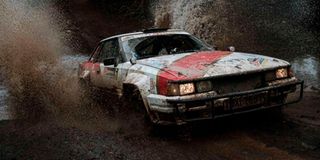History of group classification of rally cars

Kenya's rally driver Ian Duncan and Kenya's co-driver Tej Sehmi drive over a stream during the African Rally Championship (ARC) Equator Rally Kenya at the Kenya Wildlife Services Institute in Naivasha, Kenya, on April 24, 2021, ahead of the return of the World Rally Championship (WRC) scheduled in Kenya in June 2021 after 19 years.
What you need to know:
- Njiru, Duncan are listed as members of exclusive club of Subaru folklore
Kenyans are getting confused with these brands: Group B, R5, and Group N.
Where did the Group N start and why is this model so popular with drivers and commoners?
It started in 1990. In the portal, www.subaru-global.com, the Group N Subaru Legacy was until 2006 a source of pride for Fuji Heavy Industries of Japan, the manufacturer of Subaru cars and an inspiration to budding racing drivers when rallying headlined the company’s motorsport division, Subaru Technica International (STi).
In the website, which concentrates more on Subaru models trade news, the Motorsport Archives Link is a living testament of Kenya’s past special place in global rally sport.
Of the 27 Subaru works drivers from various nationalities, including seven former world champions, two are Kenyans: Patrick Njiru and Ian Duncan.
The two are listed as members of an exclusive club of Subaru motorsport folklore having helped build the Subaru brand name from anonymity to become one of the most successful international rally cars, particularly the aggressive, all-conquering Subaru Impreza STi WRX model that once commanded a near cult following globally among the fast and furious.
The Subaru craze that was started by Njiru in Kenya when he drove the marquee from 1984 to 1999, finally reached the yuppies of Kenya’s emerging middle class recently following an influx of second-hand imports of the Impreza WRX STi model from Japan and Europe.
Under the STi banner, Subaru debuted in international motorsport in the ‘80s in the under-powered Subaru Leone one was actually driven by Njiru in 1987 to 17th position when he broke the eight-year jinx of African drivers’ failure to finish the Safari.
Buoyed by these notable results, Subaru debuted the turbo charged Subaru Legacy in 1990 in a fashionable manner.
Noriyuki Koseki, who had discovered Njiru and supported him in 1987, convinced Fuji Heavy Industries to prove the car’s racing potential by attempting the FIA 100,000-kilometre world record run by a turbo charged sedan.
This was achieved between January 2 and January 21, 1989, when three Japanese nationals drove the car non-stop to the Arizona Test Centre outside of Phoenix, Arizona, to break the 100,000km FIA World Land Endurance Record by maintaining an average speed of 223.345 kilometre per hour for 447 hours, 44 minutes, and 9.887 seconds, or 18.5 days.
Pit stops were made every two hours with a driver change and refueling, while tyres changes were made at 96-hour intervals, or every 21,600 kilometres.
What is a Group N car?
Convinced they had a winner, Koseki went ahead to debut the Legacy in the world market under the motorsport platform in the Safari Rally.
In 1990, Subaru made a full assault with six cars led by Finnish ace Markku Alen in the Turbo-charged Legacy RS. All the Group A Subarus retired with the exception of Jim Heather Hayes of Kenya who finished sixth overall.
Njiru was given a Group N car and finished eighth to become the first driver in the world to finish the Safari in a Group N or standard version Legacy.
So what is a Group N car? FIA replaced Group B with Group A cars after banning the Group B fire-spitting monsters that killed Henri Toivonen and Sergio Cresto.
Power was reduced from 600 brake horse power plus to 300bhp for top-level competition car introduced the Group N, or a standard showroom production car with limited modification.
The Group A car of the 90s such as the Subaru Impreza STi, Toyota Celica GT4 Turbo, Mitsubishi Lancer Evos series and Ford Escort RS had their standard trim variables with either a 2litre or 2.5 litre engine.
But the Group N power output ranges between 250-270 Bhp. Today, the Mitsubishi Lancer Evo remains the most potent Group N car in the world after Subaru withdrew from the WRC in 2007.
National champion Baldev Chager, and many others drive Group N Mitsubishi Lancer EVOs which were reclassified as NR4 since FIA extended their homologation to continue racing since 2013.
FIA also introduced the World Rally Car in 1997 with a maximum power output of 300bhp and started relaxing the rules slightly in 2013 when the maximum power output was increased to 380 Bhp.
FIA introduced the R5 category in 2012 to replace the Super 2000 class.
Leading results:
Leading provisional results from Satuday’s competitive sections of the African Rally Championship Equator Rally:
1. Carl Tundo/Tim Jessop (VW Polo) 01:39:14.4.4;
2. Tejveer Rai/Gareth Dawe (Volkswagen Polo) 01:46:29.5
3. Guy Botterill/Simon Vacy-Lyle (Toyota Etios) 01:59:28.4
4. Hamza Anwar/Riyaz Ismail (Subaru Impreza) 02:02:27.9
5. Giancarlo Davite/Sylvia Vindevogel (Mitsubishi Evo10) 02:03:12.9
6. Kepher Walubi/Mohamadi Asuman (Mitsubishi Lancer) 02:06:19.6
7. Jasmeet Chana/Ravi Chana (Mitsubishi Evo10) 02:06:31.3
8. Evans Kavisi/Absolom Aswani (Mitsubishi Evo10) 02:08:19.6
9. Steve Mwangi/Dennis Mwenda (Subaru Impreza) 02:08:58.5
10. Aakif Virani/Azhar Bhatti (Skoda Fabia RC2-R5) 02:09:30.2
11. Kailesh Chauhan/Tariq Malik (Ford Escort RS) 02:13:10.4
12. Mcrae Kimathi/Shameer Yusuf (Subaru Impreza) 02:13:16.2
13. Eric Bengi/Peter Mutuma (Mitsubishi Evo10) 02:19:21.4
14. Edward Maina/John Ngugi (Subaru Impreza) 02:24:25.2
15. Nikhil Sachania/Deep Patel (Mitsubishi Evolution 10) 02:24:27.5
16. Daren Miranda/Wayne Fernandes (Subaru Impreza) 02:27:27.6
17. Yasser Nasser/Ali Katumba/ (Subaru Impreza) 02:33:43.2
18. Geoff Mayes/Suzanne Zqagwe (Land Rover) 02:35:06.1




